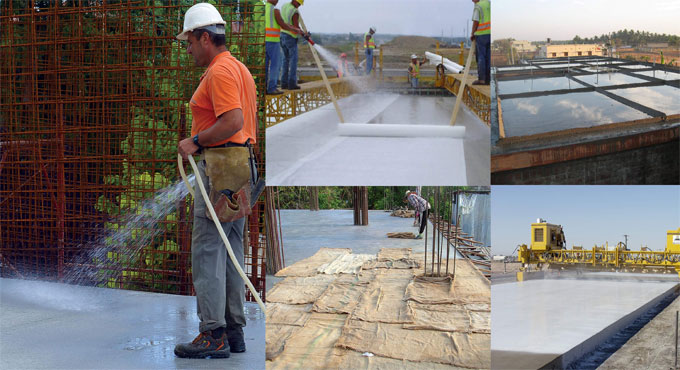
Steps in Concrete Curing Process
Curing the method in which freshly cast concrete is provided with wet conditions or moist conditions for specific time once compaction is completed. Curing is accomplished to finish the hydration reaction. Minimum 28 days are needed for normal method of curing.
The following steps are involved in curing method :-
1. SPRAYING WATER: Under this method water is sprinkled on the concrete via a hose or bucket, several times throughout each day as soon as shuttering or the framework is detached. This method is effective for small works. Proper care should be taken while implementing this method. Once the concrete becomes dry, water should be sprinkled.
2. WET GUNNY BAGS: This method is ideal for vertical surfaces of concrete like sides of column. Gunny bags are formed with jute and covered around the concrete and are retained constantly wet. Gunny bags consume water and keep moisture for a prolonged period. Gunny bags are utilized for several times and this method is very inexpensive.
3. CURING BY INFRA-RED RADIATIONS: This method is best suited for hollow concrete products where the infra-red heaters are arranged in the hollow section of the pre-cast components. This method is mostly effective in cold climatic area due to rapid gain of strength and the rapid initial temperature does not lead to reduction in ultimate strength.
4. MEMBRANE CURING: Membrane curing can be applied in the areas where the problem is extreme for water shortage. Water mixed at the time of producing fresh concrete is normally adequate for the complete hydration reaction.
Under this method a sealing membrane is used over concrete that will entrap the water inside so that the water can?t get out through evaporation. Membrane is generally a sheet of polythene or developed with application of chemicals.
The following types of sealing compounds are utilized in membrane curing:
a. Rubber latex emulsions.
2. Bituminous and asphalt emulsions.
c. Emulsions of paraffin or boiled linseed oil.
5. STEAM CURING: Steam curing is suitable for pre-cast concrete products. Because of steam, the components are heated homogeneously and the strength is achieved at a very rapid rate. Steam can pass and infiltrate through small gaps of stacked pre-cast concrete products and strength is obtained consistently from all sides.
Steam curing is performed in the following ways:
a. LOW PRESSURE STEAM CURING: Under this method the steam curing is performed at atmospheric pressure and about 70% of the 28-days strength is gained in 16-24 hours.
b. HIGH PRESSURE STEAM CURING: Under this method steam curing is performed at a pressure of 8 atmospheres that is 800KN/m2. Due to rapid curing, the temperature is increased quickly and the strength is decreased. This problems can be resolved with high pressure. High pressure steam curing provides greater stability to concrete.
6. PONDING METHOD: Ponding method is utilized for big slab and for road pavements. On top of the slab, small ponds are arranged from clayey soil, and water is accumulated up to a depth of 50mm for 28 days. The drinkable water with standard or filtered quality should be applied in ponding.
DURATION OF CURING: Concrete should not be dried rapidly in any circumstances. This condition should be retained for 24 hours. It is recommended to put the concrete under wet gunny bags for 24 hours and then apply water by means of ponding or spraying. The curing period differs for several structures, situations, various atmospheric conditions, cement type and grade utilized and mix proportion. Normally, concrete should be cured minimum for seven days when Ordinary Portland Cement is employed. In case rapid hardening cement is used, the period can be shortened to some extent. In case low heat cement is applied curing is expanded to 21 days. In cold weather areas, curing should be conducted for a prolonged period.


